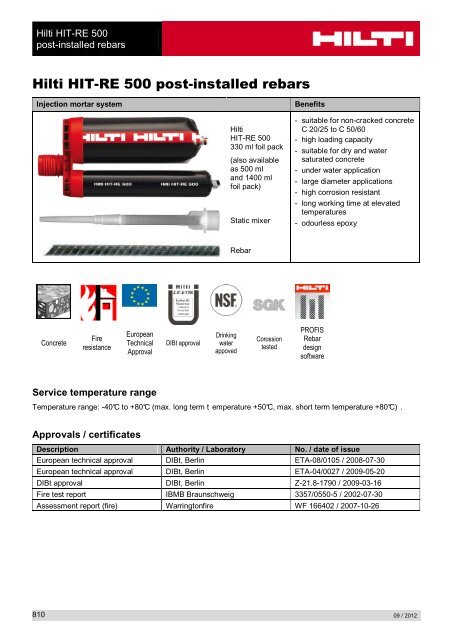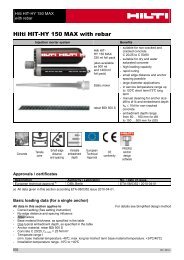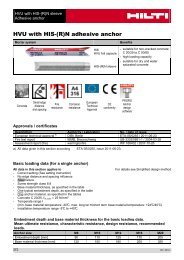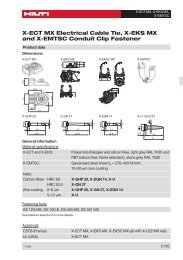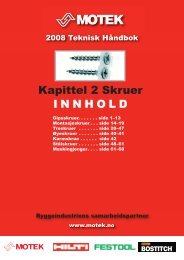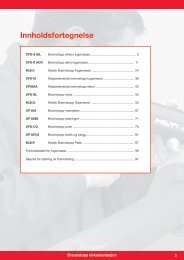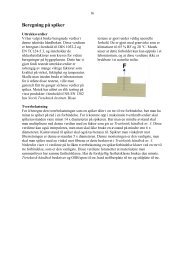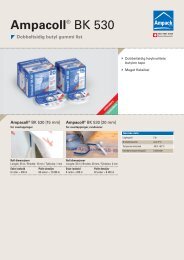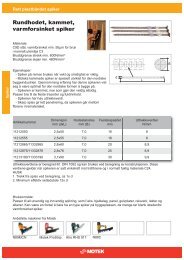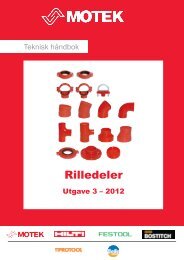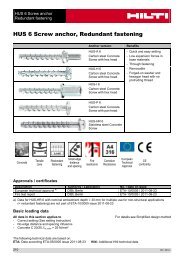Hilti HIT-RE 500 post-installed rebars - Motek
Hilti HIT-RE 500 post-installed rebars - Motek
Hilti HIT-RE 500 post-installed rebars - Motek
You also want an ePaper? Increase the reach of your titles
YUMPU automatically turns print PDFs into web optimized ePapers that Google loves.
<strong>Hilti</strong> <strong>HIT</strong>-<strong>RE</strong> <strong>500</strong><br />
<strong>post</strong>-<strong>installed</strong> <strong>rebars</strong><br />
<strong>Hilti</strong> <strong>HIT</strong>-<strong>RE</strong> <strong>500</strong> <strong>post</strong>-<strong>installed</strong> <strong>rebars</strong><br />
Injection mortar system<br />
Benefits<br />
<strong>Hilti</strong><br />
<strong>HIT</strong>-<strong>RE</strong> <strong>500</strong><br />
330 ml foil pack<br />
(also available<br />
as <strong>500</strong> ml<br />
and 1400 ml<br />
foil pack)<br />
Static mixer<br />
- suitable for non-cracked concrete<br />
C 20/25 to C 50/60<br />
- high loading capacity<br />
- suitable for dry and water<br />
saturated concrete<br />
- under water application<br />
- large diameter applications<br />
- high corrosion resistant<br />
- long working time at elevated<br />
temperatures<br />
- odourless epoxy<br />
Rebar<br />
Concrete<br />
Fire<br />
resistance<br />
European<br />
Technical<br />
Approval<br />
DIBt approval<br />
Drinking<br />
water<br />
appoved<br />
Corossion<br />
tested<br />
PROFIS<br />
Rebar<br />
design<br />
software<br />
Service temperature range<br />
Temperature range: -40°C to +80°C (max. long term t emperature +50°C, max. short term temperature +80°C) .<br />
Approvals / certificates<br />
Description Authority / Laboratory No. / date of issue<br />
European technical approval DIBt, Berlin ETA-08/0105 / 2008-07-30<br />
European technical approval DIBt, Berlin ETA-04/0027 / 2009-05-20<br />
DIBt approval DIBt, Berlin Z-21.8-1790 / 2009-03-16<br />
Fire test report IBMB Braunschweig 3357/0550-5 / 2002-07-30<br />
Assessment report (fire) Warringtonfire WF 166402 / 2007-10-26<br />
810<br />
09 / 2012
<strong>Hilti</strong> <strong>HIT</strong>-<strong>RE</strong> <strong>500</strong><br />
<strong>post</strong>-<strong>installed</strong> <strong>rebars</strong><br />
Materials<br />
Reinforcmenent bars according to EC2 Annex C Table C.1 and C.2N.<br />
Properties of reinforcement<br />
Product form<br />
Bars and de-coiled rods<br />
Class B C<br />
Characteristic yield strength f yk or f 0,2k (MPa) 400 to 600<br />
Minimum value of k = (f t /f y ) k ≥ 1,08<br />
≥ 1,15<br />
< 1,35<br />
Characteristic strain at maximum force, ε uk (%) ≥ 5,0 ≥ 7,5<br />
Bendability<br />
Maximum deviation from<br />
nominal mass<br />
(individual bar) (%)<br />
Bond:<br />
Minimum relative rib area,<br />
f R,min<br />
Nominal bar size (mm)<br />
≤ 8<br />
> 8<br />
Nominal bar size (mm)<br />
8 to 12<br />
> 12<br />
Bend / Rebend test<br />
± 6,0<br />
± 4,5<br />
0,040<br />
0,056<br />
Setting details<br />
For detailed information on installation see instruction for use given with the package of the product.<br />
Curing time for general conditions<br />
Data according ETA-08/0105, issue 2008-06-30<br />
Temperature<br />
of the<br />
Working time in which<br />
rebar can be inserted and<br />
Initial curing time<br />
t cure,ini<br />
Curing time before rebar<br />
can be fully loaded t cure<br />
base material<br />
adjusted t gel<br />
5 °C ≤ T BM < 10 °C 2 h 18 h 72 h<br />
10 °C ≤ T BM < 15 °C 90 min 12 h 48 h<br />
15 °C ≤ T BM < 20 °C 30 min 9 h 24 h<br />
20 °C ≤ T BM < 25 °C 20 min 6 h 12 h<br />
25 °C ≤ T BM < 30 °C 20 min 5 h 12 h<br />
30 °C ≤ T BM < 40 °C 12 min 4 h 8 h<br />
T BM = 40 °C 12 min 4 h 4 h<br />
For dry concrete curing times may be reduced according to the following table. For installation temperatures below<br />
+5 °C all load values have to be reduced according to the load reduction factors given below.<br />
Curing time for dry concrete<br />
Temperature<br />
of the<br />
base material<br />
Additional <strong>Hilti</strong> technical data<br />
Working time in which<br />
rebar can be inserted and<br />
adjusted t gel<br />
Initial curing<br />
time<br />
t cure,ini<br />
Reduced curing time<br />
before rebar can be<br />
fully loaded t cure<br />
Load<br />
reduction<br />
factor<br />
T BM = -5 °C 4 h 36 h 72 h 0,6<br />
T BM = 0 °C 3 h 25 h 50 h 0,7<br />
T BM = 5 °C 2 ½ h 18 h 36 h 1<br />
T BM = 10 °C 2 h 12 h 24 h 1<br />
T BM = 15 °C 1 ½ h 9 h 18 h 1<br />
T BM = 20 °C 30 min 6 h 12 h 1<br />
T BM = 30 °C 20 min 4 h 8 h 1<br />
T BM = 40 °C 12 min 2 h 4 h 1<br />
09 / 2012 811
<strong>Hilti</strong> <strong>HIT</strong>-<strong>RE</strong> <strong>500</strong><br />
<strong>post</strong>-<strong>installed</strong> <strong>rebars</strong><br />
Dry and water-saturated concrete, hammer drilling<br />
a)<br />
a ) Note: Manual cleaning for element sizes d ≤ 16mm and embedment depth h ef ≤ 20 d only!<br />
812<br />
09 / 2012
<strong>Hilti</strong> <strong>HIT</strong>-<strong>RE</strong> <strong>500</strong><br />
<strong>post</strong>-<strong>installed</strong> <strong>rebars</strong><br />
Dry and water-saturated concrete, diamond coring drilling; <strong>Hilti</strong> technical information only<br />
a) Note: Manual cleaning for element sizes d ≤ 16mm and embedment depth h ef ≤ 20 d only!<br />
Fitness for use<br />
Some creep tests have been conducted in accordance with ETAG guideline 001 part 5 and TR 023 in the following<br />
conditions : in dry environnement at 50 °C during 90 days.<br />
These tests show an excellent behaviour of the <strong>post</strong>-<strong>installed</strong> connection made with <strong>HIT</strong>-<strong>RE</strong> <strong>500</strong>: low<br />
displacements with long term stability, failure load after exposure above reference load.<br />
09 / 2012 813
<strong>Hilti</strong> <strong>HIT</strong>-<strong>RE</strong> <strong>500</strong><br />
<strong>post</strong>-<strong>installed</strong> <strong>rebars</strong><br />
Resistance to chemical substances<br />
Categories Chemical substances resistant Non resistant<br />
Alkaline products<br />
Drilling dust slurry pH = 12,6 +<br />
Potassium hydroxide solution (10%) pH = 14 +<br />
Acetic acid (10%) +<br />
Acids<br />
Nitric acid (10%) +<br />
Hydrochloric acid (10%) +<br />
Sulfuric acid (10%) +<br />
Benzyl alcohol +<br />
Ethanol +<br />
Solvents<br />
Ethyl acetate +<br />
Methyl ethyl keton (MEK) +<br />
Trichlor ethylene +<br />
Xylol (mixture) +<br />
Concrete plasticizer +<br />
Diesel +<br />
Products from job site Engine oil +<br />
Petrol +<br />
Oil for form work +<br />
Sslt water +<br />
Environnement<br />
De-mineralised water +<br />
Sulphurous atmosphere (80 cycles) +<br />
Electrical Conductivity<br />
<strong>HIT</strong>-<strong>RE</strong> <strong>500</strong> in the hardened state does not conduct electrically. Its electric resistivity is 66⋅10 12 Ω.m<br />
(DIN IEC 93 – 12.93). It is adapted well to realize electrically insulating anchorings (ex: railway applications,<br />
subway).<br />
814<br />
09 / 2012
<strong>Hilti</strong> <strong>HIT</strong>-<strong>RE</strong> <strong>500</strong><br />
<strong>post</strong>-<strong>installed</strong> <strong>rebars</strong><br />
Drilling diameters<br />
Rebar (mm)<br />
Hammer drill (HD)<br />
Drill bit diameters d 0 [mm]<br />
Compressed air<br />
drill (CA)<br />
Wet (DD)<br />
Diamond coring<br />
Dry (PCC)<br />
8 12 (10 a) ) - 12 (10 a) ) -<br />
10 14 (12 a) ) - 14 (12 a) ) -<br />
12 16 (14 a) ) 17 16 (14 a) ) -<br />
14 18 17 18 -<br />
16 20 20 20 -<br />
18 22 22 22 -<br />
20 25 26 25 -<br />
22 28 28 28 -<br />
24 32 32 32 35<br />
25 32 32 32 35<br />
26 35 35 35 35<br />
28 35 35 35 35<br />
30 37 35 37 35<br />
32 40 40 40 47<br />
34 45 42 42 47<br />
36 45 45 47 47<br />
40 55 57 52 52<br />
a) Max. installation length I = 250 mm.<br />
09 / 2012 815
<strong>Hilti</strong> <strong>HIT</strong>-<strong>RE</strong> <strong>500</strong><br />
<strong>post</strong>-<strong>installed</strong> <strong>rebars</strong><br />
Basic design data for rebar design according to rebar ETA<br />
Bond strength in N/mm² according to ETA 08/0105 for good bond conditions<br />
for hammer drilling, compressed air drilling, dry diamond core drilling<br />
Rebar (mm)<br />
Concrete class<br />
C12/15 C16/20 C20/25 C25/30 C30/37 C35/45 C40/50 C45/55 C50/60<br />
8 - 32 1,6 2,0 2,3 2,7 3,0 3,4 3,7 4,0 4,3<br />
34 1,6 2,0 2,3 2,6 2,9 3,3 3,6 3,9 4,2<br />
36 1,5 1,9 2,2 2,6 2,9 3,3 3,6 3,8 4,1<br />
40 1,5 1,8 2,1 2,5 2,8 3,1 3,4 3,7 4,0<br />
Bond strength in N/mm² according to ETA 08/0105 for good bond conditions<br />
for wet diamond core drilling<br />
Rebar (mm)<br />
Concrete class<br />
C12/15 C16/20 C20/25 C25/30 C30/37 C35/45 C40/50 C45/55 C50/60<br />
8 - 25 1,6 2,0 2,3 2,7 3,0 3,4 3,7 4,0 4,3<br />
26 - 32 1,6 2,0 2,3 2,7 2,7 2,7 2,7 2,7 2,7<br />
34 1,6 2,0 2,3 2,6 2,6 2,6 2,6 2,6 2,6<br />
36 1,5 1,9 2,2 2,6 2,6 2,6 2,6 2,6 2,6<br />
40 1,5 1,8 2,1 2,5 2,5 2,5 2,5 2,5 2,5<br />
Pullout design bond strength for Hit Rebar design<br />
Design bond strength in N/mm² according to ETA 04/0027 (values in table are<br />
design values, fbd,po = τRk/γMp<br />
Hammer or compressed air drilling.<br />
Water saturated, water filled or submerged hole.<br />
Uncracked concrete C20/25.<br />
temperature<br />
range<br />
Bar diameter<br />
Data according to ETA 04/0027<br />
<strong>Hilti</strong> tech data<br />
8 10 12 14 16 20 22 24 25 26 28 30 32 36 40<br />
I: 40°C/24°C 7,1 6,7 6,2 5,2 4,8<br />
II: 58°C/35°C 5,7 5,2 4,8 4,3 3,8<br />
III: 70°C/43°C 3,3 3,1 2,9 2,4<br />
Increasing factor in non-cracked concrete: f B,p =(f cck /25) 0,1<br />
(f cck : characteristic compressive strength on cube)<br />
Additional <strong>Hilti</strong> Technical Data:<br />
If the concrete is dry (not in contact with water before/during installation and curing), the pullout design bond<br />
strength may be increased by 20%.<br />
If the hole was produced by wet diamond coring, the pullout design bond strength has to be reduced by 30%.<br />
Reduction factor for splitting with large concrete cover: δ = 0,306 (<strong>Hilti</strong> additional data)<br />
816<br />
09 / 2012
<strong>Hilti</strong> <strong>HIT</strong>-<strong>RE</strong> <strong>500</strong><br />
<strong>post</strong>-<strong>installed</strong> <strong>rebars</strong><br />
Fire Resistance according to DIBt Z-21.8-1790<br />
a) fire situation “anchorage”<br />
l inst<br />
Maximum force in rebar in conjunction with <strong>HIT</strong>-<strong>RE</strong> <strong>500</strong> as a function of embedment depth for the fire<br />
resistance classes F30 to F180 (yield strength f yk = <strong>500</strong> N/mm²) according EC2 a) .<br />
Bar ∅<br />
Drill hole<br />
∅<br />
Max. F s,T l inst Fire resistance of bar in [kN]<br />
[mm] [mm] [kN] [mm] R30 R60 R90 R120 R180<br />
80 2,4 1,0 0,5 0,3 0<br />
95 3,9 1,7 0,3 0,6 0,1<br />
115 7,3 3,1 1,7 1,1 0,4<br />
8 10 16,19<br />
150 16,2 8,2 4,6 3,1 1,4<br />
180 16,2 10,0 6,7 2,9<br />
205 16,2 12,4 5,1<br />
220 16,2 7,0<br />
265 16,2<br />
100 5,7 2,5 1,3 0,8 0,2<br />
120 10,7 4,4 2,5 1,7 0,7<br />
140 17,6 7,8 4,4 3,0 1,3<br />
10 12 25,29<br />
165 25,3 15,1 8,5 5,8 2,6<br />
195 25,3 17,6 12,2 5,1<br />
220 25,3 20,7 8,7<br />
235 25,3 11,8<br />
280 25,3<br />
120 12,8 5,3 3,0 2,0 0,8<br />
150 25,2 12,2 6,9 4,7 2,1<br />
180 36,4 24,3 15,0 10,1 4,4<br />
12 16 36,42 210 36,2 27,4 20,6 8,5<br />
235 36,4 31,0 14,2<br />
250 36,4 19,1<br />
295 36,4<br />
140 24,6 10,9 6,1 4,2 1,9<br />
170 39,1 23,5 13,5 9,2 4,1<br />
195 49,6 35,6 24,7 17,1 7,2<br />
14 18 49,58 225 49,6 39,2 31,3 13,5<br />
250 49,6 43,4 22,3<br />
265 49,6 29,5<br />
310 49,6<br />
160 39,2 21,3 11,9 8,1 3,6<br />
190 55,8 37,9 25,5 17,3 7,3<br />
210 64,8 49,0 36,5 27,5 11,3<br />
16 20 64,75 240 64,8 53,1 44,1 20,9<br />
265 64,8 57,9 33,7<br />
280 64,8 42,0<br />
325 64,8<br />
09 / 2012 817
<strong>Hilti</strong> <strong>HIT</strong>-<strong>RE</strong> <strong>500</strong><br />
<strong>post</strong>-<strong>installed</strong> <strong>rebars</strong><br />
Bar ∅<br />
Drill hole<br />
∅<br />
Max. F s,T<br />
l inst<br />
[mm] [mm] [kN] [mm] R30 R60 R90 R120 R180<br />
200 76,6 54,3 38,7 27,5 11,4<br />
240 101,2 82,0 66,4 55,1 26,1<br />
20 25 101,18<br />
270 101,2 87,1 75,9 45,6<br />
295 101,2 93,2 62,9<br />
310 101,2 73,2<br />
355 101,2<br />
250 139,0 111,1 91,6 77,6 39,9<br />
275 158,1 132,7 113,2 99,2 61,3<br />
25 30 158,09<br />
305 158,1 139,1 125,1 87,2<br />
330 158,1 146,7 108,8<br />
345 158,1 121,8<br />
390 158,1<br />
280 184,7 153,4 131,6 115,9 73,5<br />
295 198,3 168,0 146,1 130,4 88,0<br />
28 35 198.3<br />
330 198,3 180,0 164,3 121,9<br />
350 198,3 183,6 141,2<br />
370 198,3 160,6<br />
410 198,3<br />
320 255,3 219,6 194,7 176,7 128,2<br />
325 259,0 225,1 200,2 182,2 133,8<br />
32 40 259,02<br />
360 259,0 238,9 220,9 172,5<br />
380 259,0 243,1 194,6<br />
395 259,0 211,2<br />
440 259,0<br />
400 404,7 385,1 353,9 331,5 270,9<br />
415 404,7 374,6 352,2 291,6<br />
40 47 404,71 440 404,7 386,8 326,2<br />
455 404,7 346,9<br />
<strong>500</strong> 404,7<br />
a)<br />
For tables according the standards to DIN 1045-1988, NF-ENV 1991-2-2(EC2), Österreichische Norm B 4700-<br />
2000, British-, Singapore- and Australian Standards see Warringtonfire report WF 166402 or/and IBMB<br />
Braunschweig report No 3357/0550-5.<br />
818<br />
09 / 2012
<strong>Hilti</strong> <strong>HIT</strong>-<strong>RE</strong> <strong>500</strong><br />
<strong>post</strong>-<strong>installed</strong> <strong>rebars</strong><br />
b) fire situation parallel<br />
Max. bond stress, τ T , depending on actual clear concrete cover for classifying the fire resistance.<br />
It must be verified that the actual force in the bar during a fire, F s,T , can be taken up by the bar connection of the<br />
selected length, l inst . Note: Cold design for ULS is mandatory.<br />
F s, T ≤ (l inst – c f )⋅ φ ⋅ π ⋅ τ T where: (l inst – c f ) ≥ l s ;<br />
l s<br />
φ<br />
= lap length<br />
= nominal diameter of bar<br />
l inst – c f = selected overlap joint length; this must be at least l s ,<br />
but may not be assumed to be more than 80 φ<br />
τ T<br />
= bond stress when exposed to fire<br />
Critical temperature-dependent bond stress, τ c , concerning “overlap joint” for <strong>Hilti</strong> <strong>HIT</strong>-<strong>RE</strong> <strong>500</strong> injection<br />
adhesive in relation to fire resistance class and required minimum concrete coverage c.<br />
Clear concrete cover c<br />
Max. bond stress, τ c [N/mm²]<br />
[mm] R30 R60 R90 R120 R180<br />
30 0,7 0<br />
35 0,8 0,4<br />
40 0,9 0,5<br />
0<br />
45 1,0 0,5<br />
0<br />
50 1,2 0,6<br />
55 1,4 0,7 0,5<br />
60 1,6 0,8 0,5<br />
0<br />
65 1,9 0,9 0,6 0,4<br />
70<br />
1,0 0,7 0,5<br />
75 1,2 0,7 0,5<br />
80 1,4 0,8 0,6<br />
85 1,5 0,9 0,7<br />
90 1,7 1,1 0,8 0,5<br />
95 2,0 1,2 0,9 0,5<br />
100<br />
1,4 1,0 0,6<br />
105 1,6 1,1 0,6<br />
110 1,7 1,2 0,7<br />
115 2,0 1,4 0,7<br />
120<br />
1,6 0,8<br />
2,2<br />
125 1,7 0,9<br />
130 2,0 1,0<br />
135<br />
1,1<br />
2,2<br />
140 1,2<br />
145 1,3<br />
2,2<br />
150 1,4<br />
155 2,2<br />
1,6<br />
160 1,7<br />
165 1,9<br />
170 2,1<br />
175 2,2<br />
09 / 2012 819
<strong>Hilti</strong> <strong>HIT</strong>-<strong>RE</strong> <strong>500</strong><br />
<strong>post</strong>-<strong>installed</strong> <strong>rebars</strong><br />
Minimum anchorage length<br />
According to ETA-08/0105, issue 2008-06-30, the minimum anchorage length shall be increased by factor 1,5 for<br />
wet diamond core drilling. For all the other given drilling methods the factor is 1,0.<br />
Minimum anchorage and lap lengths for C20/25; maximum hole lengths (ETA<br />
08/0105)<br />
Diameter<br />
d s<br />
[mm]<br />
Rebar<br />
f y,k<br />
[N/mm²]<br />
Hammer drilling,<br />
Compressed air drilling,<br />
Dry diamond coring drilling<br />
l b,min *<br />
[mm]<br />
l 0,min *<br />
[mm]<br />
Wet diamond coring<br />
drilling<br />
l b,min *<br />
[mm]<br />
l 0,min *<br />
[mm]<br />
l max<br />
[mm]<br />
8 <strong>500</strong> 113 200 170 300 1000<br />
10 <strong>500</strong> 142 200 213 300 1000<br />
12 <strong>500</strong> 170 200 255 300 1200<br />
14 <strong>500</strong> 198 210 298 315 1400<br />
16 <strong>500</strong> 227 240 340 360 1600<br />
18 <strong>500</strong> 255 270 383 405 1800<br />
20 <strong>500</strong> 284 300 425 450 2000<br />
22 <strong>500</strong> 312 330 468 495 2200<br />
24 <strong>500</strong> 340 360 510 540 2400<br />
25 <strong>500</strong> 354 375 532 563 2<strong>500</strong><br />
26 <strong>500</strong> 369 390 553 585 2600<br />
28 <strong>500</strong> 397 420 595 630 2800<br />
30 <strong>500</strong> 425 450 638 675 3000<br />
32 <strong>500</strong> 454 480 681 720 3200<br />
34 <strong>500</strong> 492 510 738 765 3200<br />
36 <strong>500</strong> 532 540 797 810 3200<br />
40 <strong>500</strong> 616 621 925 932 3200<br />
* l b,min (8.6) and l 0,min (8.11) are calculated for good bond conditions with maximum utilisation of rebar yield<br />
strength f yk = <strong>500</strong> N/mm² and α 6 = 1,0<br />
820<br />
09 / 2012
<strong>Hilti</strong> <strong>HIT</strong>-<strong>RE</strong> <strong>500</strong><br />
<strong>post</strong>-<strong>installed</strong> <strong>rebars</strong><br />
09 / 2012 821


